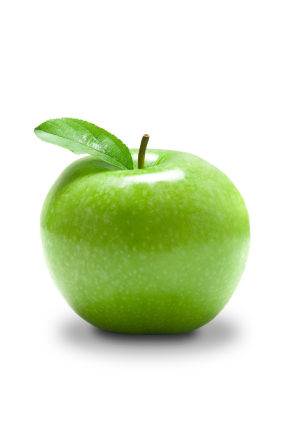

"I hardly ever feel full," is a common statement made by people who struggle with overeating. Unfortunately, satiety cues (the sensation of feeling hungry and full) can become warped by years of yo-yo dieting. Gigantic portion sizes, like the kind you find at restaurants, don't help either. Too often we turn to external cues to let us know when to stop eating (ex. you finished your entire plate or everyone gets up from the table) rather than internal cues (stomach feeling satisfied).
Can an apple help you relearn satiety cues and eat more mindfully? It can be a step in the right direction. But, it's not eating just any version of an apple. In a 2009 study by Flood-Obbagy and Rolls, subjects were given either apple juice, apple sauce or a whole apple before a meal. They found that the way the apple was served made a significant difference in how much subjects consumed later. People who ate an entire apple prior to lunch consumed 15% less compared to those who had nothing at all before the meal. A pre-meal apple reduced eating more than the apple juice or apple sauce.
Why is eating an entire apple the best bet? In part, the apple's fiber helps you to feel fuller and more satisfied. In turn, you are more mindful of the sensations in your stomach. However, even when fiber was added to the juice in this study, the whole apple still wins.
In part, it may be the psychological effect of holding a piece of fruit in your hand. You perceive it as more filling due to the volume. Also, eating an apple stimulates your senses. It has a loud crunch, it is sweet or sour enough to make your mouth pucker, and it takes some time and effort to eat. This is mindful eating in a nutshell-tuning into your sensations while you eat.
Check out the book, Volumetrics, by Barbara Rolls. She discusses other specific foods that can assist you in feeling fuller, on high volume, low energy dense foods. These foods help your body learn to recognize when you are hungry and when you are full.
The Lesson: The trick to mindful eating is getting in touch with your satiety cues. The pre-meal apple may give you a jump start in learning how to do this.
To learn other tools for mindful eating and ways to cope with stress eating, see 50 Ways to Soothe Yourself Without Food or www.eatingmindfully.com.
Susan Albers, Psy.D. is a clinical psychologist at the Cleveland Clinic Hospital who specializes in eating issues and body image concerns. She is an alumni of the University of Denver and the author of four books, 'Eating Mindfully: How to End Mindless Eating and Develop a Balanced Relationship to Food (New Harbinger, 2003' and 'Mindful Eating 101: A Guide to Healthy Eating in College & Beyond (Routledge, 2006) Eat, Drink & Be Mindful (New Harbinger Publications, 2009) and 50 Ways to Soothe Yourself without Food (August, 2009). Dr. Albers completed her internship at the University of Notre Dame and a post doctoral fellowship at Stanford University. Her work has been featured in the Wall Street Journal, O, the Oprah Magazine, Self and Natural Health. Dr. Albers gives mindful eating workshops internationally.